Cerritos College Art Gallery SUR:Biennial 2019
SUR:Biennial > 2019 > Cerritos
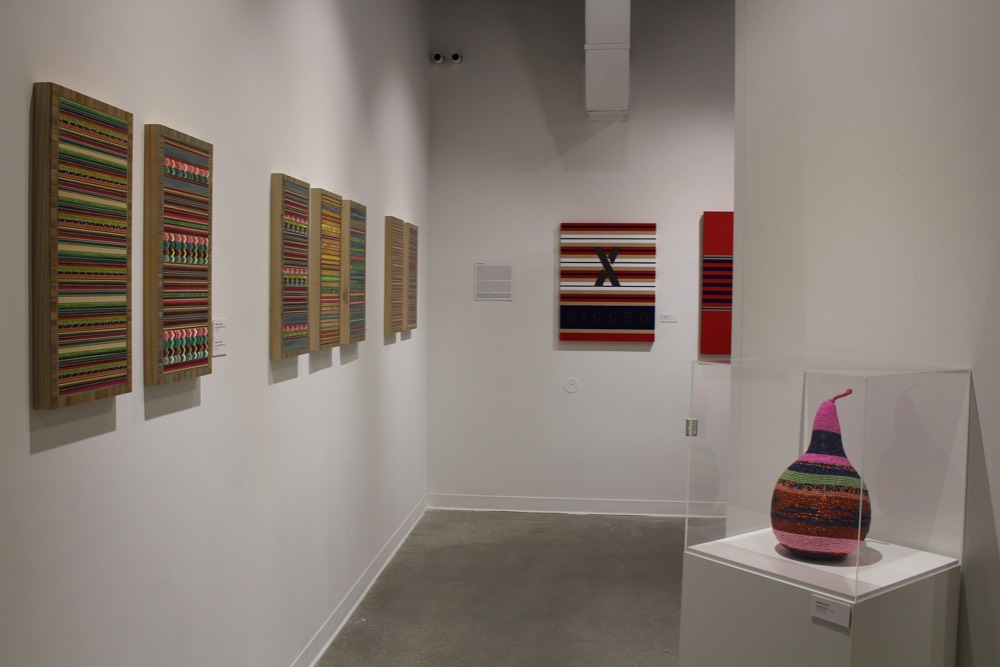
Installation Image at Cerritos College.
SOUTHERN GEOMETRIES
CONTEMPORARY NON-OBJECTIVE ART AND THE LATIN AMERICAN DIASPORA
Discussions around the history of Latin American Art are often dominated by representational imagery, frequently presented in popular community-oriented mediums such as printmaking and muralism. However, this particular focus can overshadow the long-standing influence of abstraction and non-objective production in Latin America from Pre-Columbian architecture and indigenous textile designs to influential mid-century modernist movements such as Arte Madí in Argentina, Neoconcretismo in Brazil, and Kinetic/Op Art in Venezuela.
Southern Geometries, at the Cerritos College Art Gallery, highlights the non-objective work of seven contemporary artists from the Latin American diaspora. Building upon the abstract and non-objective traditions of the past, each of these artists has developed their own distinct approaches to artistic production, often transecting an overt interest in compositional innovation with a simultaneous focus on issues such as physicality, materiality, and referentiality.
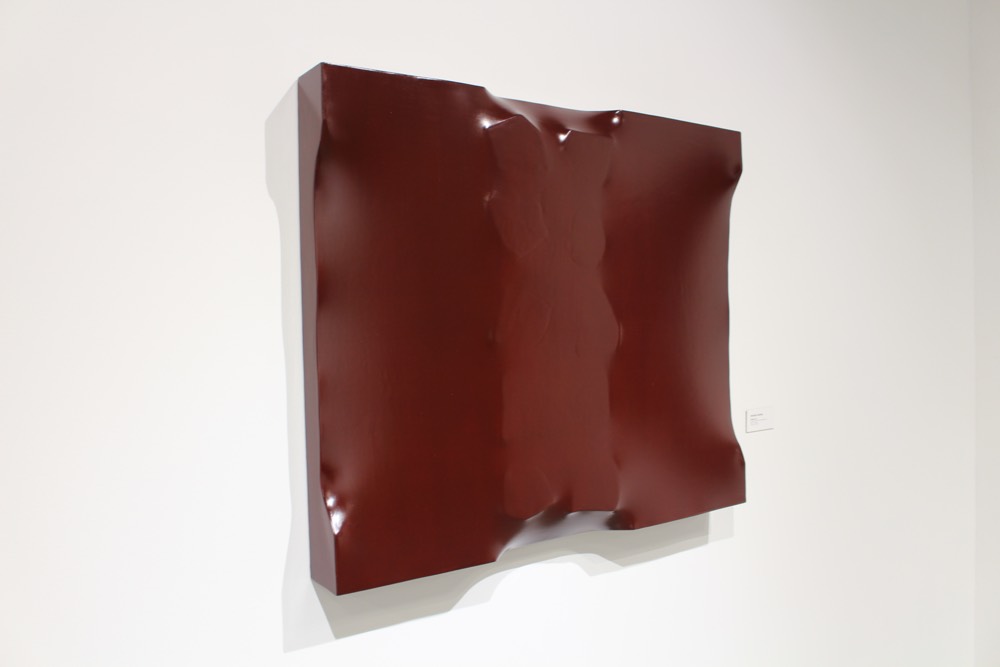
Eduardo Aispuro, Untitled, Acrylic on Canvas, 30" x 36" x 5", 2019.
Eduardo Aispuro
Eduardo Aispuro builds shaped canvases that exist somewhere between painted surface and sculptural form. Rejecting the traditional rectangular frame, and the loaded history of Renaissance illusionism to which it is associated, Aispuro still feels compelled to maintain a connection to that powerful formal precedent in his work. The rectangle, as he sees it, defines a particular system of viewing, and not just because it serves as the theoretical window through which the viewer looks, but also because of how it orients the viewer’s body in relationship to that picture plane. The structure and the surface are forever intertwined with each other and both together reach out to engage the viewer. The history of painting within the last five hundred years has seen numerous alterations to how paint is applied to the surface, and yet, for the most part, that same history perpetuates an almost slavish reliance upon a largely unmanipulated structure.
Most painters buy commercially available pre- stretched canvases just as most homeowners buy previously constructed houses. Not Eduardo Aispuro, who builds his canvases from scratch. First, he maps out the traditional rectangular frame, but then he builds additional elements attached to, or in some cases subtracted from, this structure that will push, and/or pull, against the surface of the canvas. As he says, “there is a consequence for altering the substructure and the surface has to deal with it.” This can be seen, for example, in the massive six-foot tall piece, BlancX, Aispuro built over the summer right here at the Cerritos College Art Gallery and with the generous use of the Cerritos College woodworking facility. These alterations demand something of the viewer as well. Instead of positioning one’s body directly in front of the painting, one now moves around it, the experience of the work changing from each new angle. The phenomenological expression of the viewer’s body is therefore altered just as the surface itself is altered. And part of this perceptual shift comes from the allusion to tension just beneath the surface, a tension caused by forms that the viewer can never experience directly. The notion of the obscured view is taken to its logical conclusion in Aispuro’s most recent experiments with concrete. In three new pieces created for the SUR:biennial, Aispuro covers his stretched canvas forms with an additional treatment, a plane of flat concrete hovering just above the canvas in a way that almost completely obscures the viewer’s ability to experience the work underneath.
Eduardo Aispuro was born and raised in California’s Central Valley. He holds a BFA from UC Santa Barbara and a MFA from UC Irvine. His two-person exhibition with Patricia Liverman, Time Under Tension, recently closed at the Irvine Fine Arts Center. His solo exhibitions include Transitions at the Frank M. Doyle Arts Pavilion at Orange Coast College, Body and Reverb at the Irvine Contemporary Arts Center, and Structure at Gallery 479. Aispuro has served as a lecture in painting at UC Irvine, and is currently teaching at Orange Coast College, as well as serving as the director of arts education at Fusion Academy.
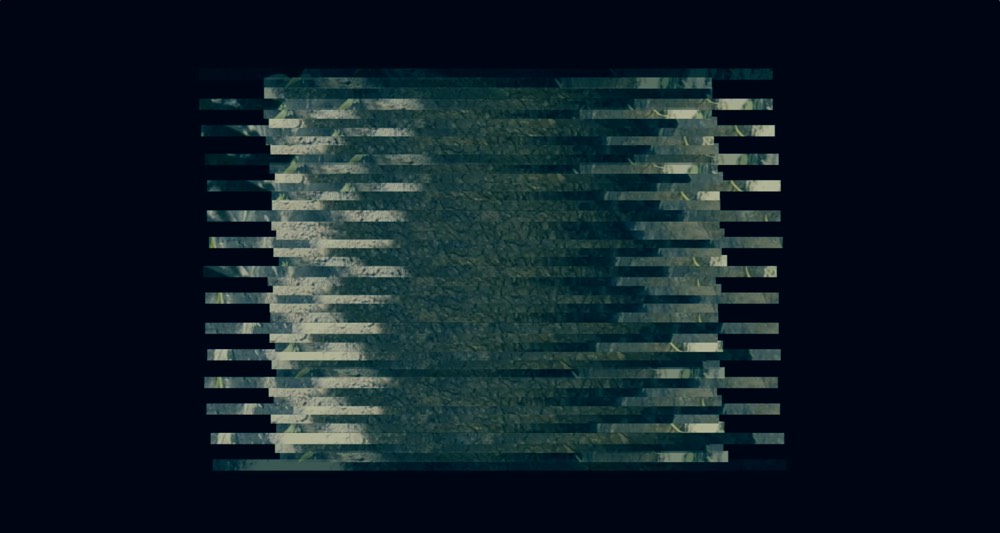
Marisa Alexander-Clarke, Still from Repetiendo Re 1, 2017 - 2019.
Marsia Alexander-Clarke
Though she started her artistic career in the 1960s as a painter, and evolved throughout
the 1970s
and 1980s into a sculptor and land artist, since the mid-1980s, she has primarily
worked in the medium of video. In her most recent video projects, including those
presented in the SUR:biennial at Cerritos College Art Gallery, Alexander-Clarke’s
mature mastery of her medium finds new, and yet quite familiar, territory. Reminiscent
in form to her skeletal structures of the 1970s, elongated linear elements fade in
and out of view, weaving together a tapestry that is forever on the loom and, as with
those earlier Nomadic Sculptures, the process is, in fact, the primary goal of the
product. Against a dark background, bars of color twist and turn, deconstructing the
naïve utopian dream of modernist stability into a composition of deceptively biomorphic
dynamism. Through a process of temporal aliasing, created by extreme cropping (a practice
that can be seen in Alexander-Clarke’s work as far back as her paintings of the sixties
and her photographs of the eighties) combined with the original motion of the camera,
illusory motion reversal confuses the viewer’s sensory perceptions. Though harkening
back to the very origins of abstraction in film and video, most notably the experiments
of Hans Richter and Viking Eggeling, these pieces in Alexander-Clarke’s extended oeuvre
have no direct precedent in video art. David Smith was known to call his sculptures
“drawings in space.” No doubt this turn of phrase was chosen to highlight a gestural
aspect of his sculptures, perhaps to compensate for his use of industrial materials
and certainly to firmly entrench his work within the authorial mystique tied to Abstract
Expressionism. It is notable, therefore, that Alexander-Clarke uses the term ‘marks’
to describe the micro-elements of her video works, seeing each repeated cropped video
fragment as an individuated unit of an ephemeral “drawing in time.” The transient
nature of these ‘video marks’ suggests the perpetual fragility of the artist’s gesture.
Only ever realized momentarily, before fading away or mutating into something else,
they highlight both the desire and the impossibility of merging the present with the
past. Witnessing these video events unfold, the consciousness of the viewer is forcibly
thrust into an ‘eternal now.’
Marsia Alexander-Clarke was born and raised in Valparaiso, Chile, and came to the
United States
to attend high school in 1952. She received her BA from Park College, Kansas City,
Kansas, in 1962,
after which she traveled to New York City to further her studies in art. In 1970,
she came to California
and from 1972 to 1974, Alexander-Clarke attended Claremont Graduate University, during
which time her high relief paintings on paper gradually became three-dimensional.
Alexander-Clarke received her MFA from CGU in 1974. A year later she was accepted
at McDowell Colony, Peterborough, New Hampshire, for a two-month scholarship residency.
Upon her return to California, Alexander-Clarke continued developing her sculptures,
which she exhibited extensively in California and nationally. In the late 1980s, she
attended video art workshops at the Pasadena Community Access Corporation. Since then,
she has worked with video as her primary medium.
In 2001, she received an Individual Artist Grant from the City of Pasadena Cultural Affairs Division for her choral video installation, 6 in 1 to 64 CHOIR, which was exhibited at the Armory Center for the Arts. In 2012, the Cerritos College Art Gallery held a 35 year retrospective of her work, tracing her evolution from a sculptor and land artist to her distinctive video-based practice. In 2018, she became a Fellow in Film-Video from the John Simon Guggenheim Memorial Foundation.
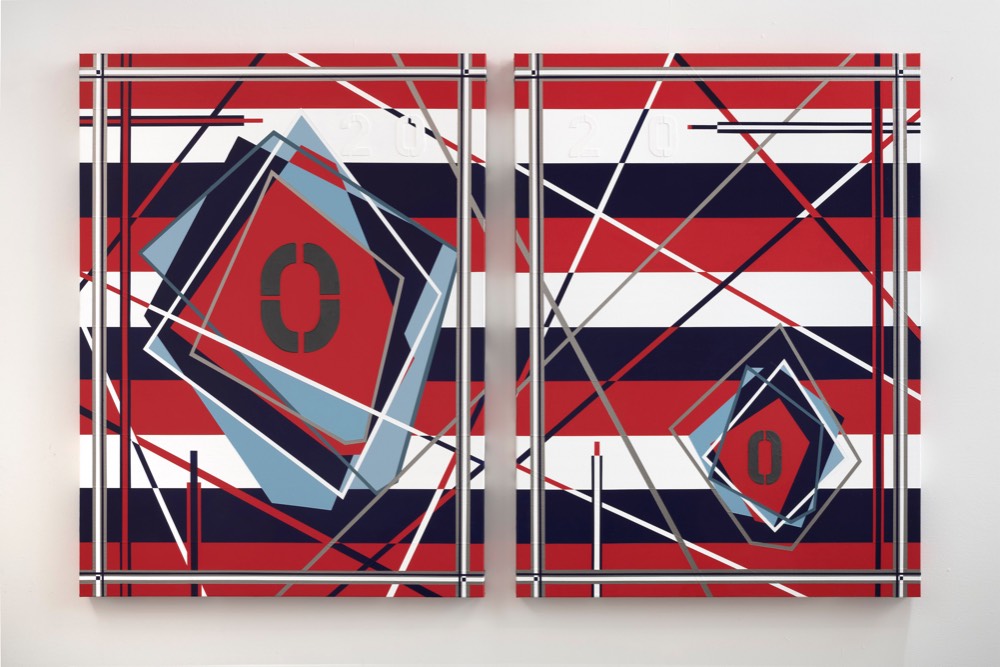
Linda Arreola, Fourth of July, Acrylic on Wood, 40" x 60", 2019.
Linda Arreola
Early in her career, Linda Arreola created sculptural works made from simple geometries, constructed of wood and steel cable. Following further studies in architecture, she went on to explore painting, installation and printmaking. Though she predominately now works as a painter, her paintings still show evidence of her early three-dimensional influences. She describes them as being built rather than rendered, with line, color, and form used as elemental building blocks from which to create abstract environments. Ever a builder, her study of architecture’s line drawings of plans and sections impacted her production methodology. Instead of applying paint along a flat plane, she layers and builds up her work with paint, thinking of them as architecturally inspired, built constructions. Influenced by the architecture of Mesoamerica and the sleek lines of modernist design, her work investigates geometric spatial arrangements using an elemental and minimalist sensibility. Her diverse influences include mentor and artist Gilbert Magú Luján, Japanese architect Tadao Ando, Minimalist sculptor Donald Judd, painter Agnes Martin, Abstract Expressionist sculptor Louise Nevelson and Pop artist Jasper Johns. In honoring the simple, the common, and the elemental, Arreola seeks to imbue her work with energy, poetry, and mystery. Just like an architectural structure requires a stable ground, the grid is the foundation on which she builds and layers her paintings, suggesting, she argues, an interconnectedness between all things and serving as a vehicle that transmits spirit. These spiritual structural environments are then populated with simple geometric forms such as the circle and square, as well as single letters or even words, humble icons manifesting a grand spirit. The bands that are present throughout the work, though structural, also suggest unlimited expansion, as with a ‘ray” in geometry. So there is concreteness as with structural elements and there is fluidness as with infinite growth and possibility, creating unique experiences that give the viewer a formal perspective that connects them to a much grander whole.
Her latest series, American X: The Beautiful, included in the SUR:biennial exhibition
at Cerritos College Art Gallery, is inspired by the difficult socio-political situation
under the current US administration. The work takes a hopeful stance driven by the
pushback from what the artist calls The American X - women, people of color, and the
LGBT community. It represents the optimism and promise of a new America driven by
the values of the American X
to lead the way back to justice, equity, and compassion for humankind and the environment.
In the segment of the series produced for the SUR:biennial, the main body of work
is limited primarily to the three colors of the American flag: red, white, and blue.
Planting the viewer firmly in the symbolism of the flag and presenting an alternative
position in protest to the inequities and injustices of our time, Arreola uses simple
geometries to construct and build a composition of structure, creating a foundation
of boldness and strength. The combination of color, form, and word are used to create
a paradoxical relationship between the symbolism of the flag colors and the word meaning.
The bold letter shapes are used also as a design element to create an interior structure
in contrast to the simple geometric forms. The letter, “O” is used to signify a portal,
the feminine, openness and change, whereas the “X” is definitive, representing strength
and, at the same time, cancellation. These works were created to address the challenges
America currently faces with the hope and promise that it can recreate itself in the
image and strength found in its diversity.
Linda Arreola is a Los Angeles based artist with a background in sculpture and architecture. She received her B.A. and M.A. degrees in sculpture from California State University Los Angeles and received a Master of Architecture from UCLA. She is one of the featured artists in the book, “Contemporary Chicana/Chicano Artists”. In 2008, she completed a Public Art Commission for the East Los Angeles Civic Center main plaza. She has been a recipient of the Durfee Foundation ARC grant, the City of Los Angeles (COLA) Individual Artist Fellowship from the Department of Cultural Affairs, and a recipient of the California Community Foundation Individual Artist Grant. Her work has been exhibited in numerous locations including Ave 50, Fullerton College Art Gallery, Cabrillo College Art Gallery, and Coagula Curatorial. Recent solo shows include Linda Arreola: Architect of the Abstract at the Vincent Price Art Museum and The Avalanche and the Silence at the Carnegie Art Museum.
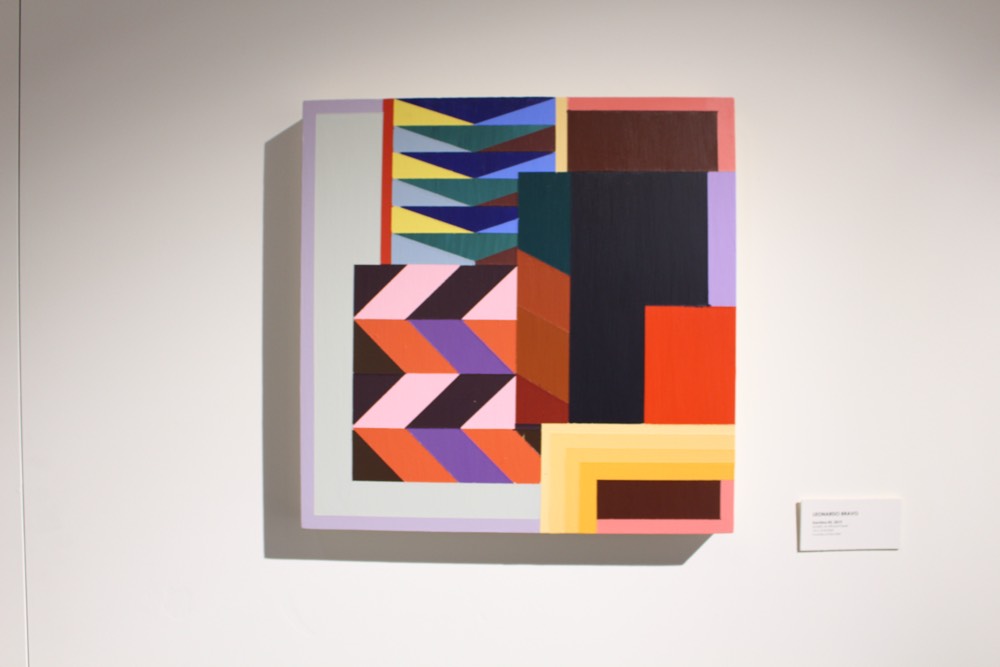
Leonardo Bravo, Kachina #7, Acrylic on Wood, 16" x 16", 2019.
Leonardo Bravo
Leonardo Bravo’s paintings draw upon the language of modernist geometric abstraction through complex structures and systems in saturated colors that suggest a constant state of becoming and unfolding. These works take their cues from a variety of sources; including Bauhaus master weavers Gunta Stolzl and Ani Albers, the wall drawings of Sol LeWitt, the works of Brazilian artist Helio Oiticica, and traditional South American woven tapestries. Inherent in these structures is the visual tension suggested by the relationship of each color form to the other, and the way in which negative space becomes a counterpoint to each fixed form. The complexity of these structures suggest an architecture of time and space in which forms continue to build and collapse upon each other, emanating new relationships, and suggesting pathways that open up to limitless possibilities, questions, and complexities. In his newest body of work, Sin Fronteras, included in SUR:biennial at Cerritos College Art Gallery, Bravo stretches elements and relationships of scale and form to explore states of fluidity, transition, and continuous movement. The individual works point to the constructs of the urban and social environment; the inherent tensions, pressures, and counter logics that form narratives of individual and collective memory, mourning, and loss; specifically the loss of exile, of migrant dispersal, of a longing for a place other than here. Yet they also position these as sites of unfettered liberation, traversing boundaries and reductive binary oppositions, ultimately shape- shifting into new subjective realities. Through the inherent tension between lines, colors, and space, the works in Sin Fronteras are akin to visual mappings or wall markings calling forth a collision of histories, voices, imaginings, and incantantions. Although these works are not by themselves illustrations of a rich source of inspiration, they function as evocations to be read, suggestive of a complex and compelling symbol system.
Leonardo Bravo is an artist, educator, and curator. Born in Santiago, Chile, Leonardo Bravo earned his BFA from OTIS Institute of Art & Design and MFA from the University of Southern California. Over the last few years his works have been exhibited at Elephant Gallery, Charlie James Gallery, The Architects Collective, BKB Art & Design, Mount San Jacinto College, and Luis De Jesus Gallery. In addition to his artistic practice, he is the founder and organizer of Big City Forum, an interdisciplinary, social practice, and curatorial research project that brings attention to emergent practices across design, architecture, and the arts, providing an ongoing exploration of the intersections between these creative disciplines and new ways of knowledge making within the context of public space and social change. He currently serves as the Director of Education and Public Programs at the Palm Springs Art Museum.
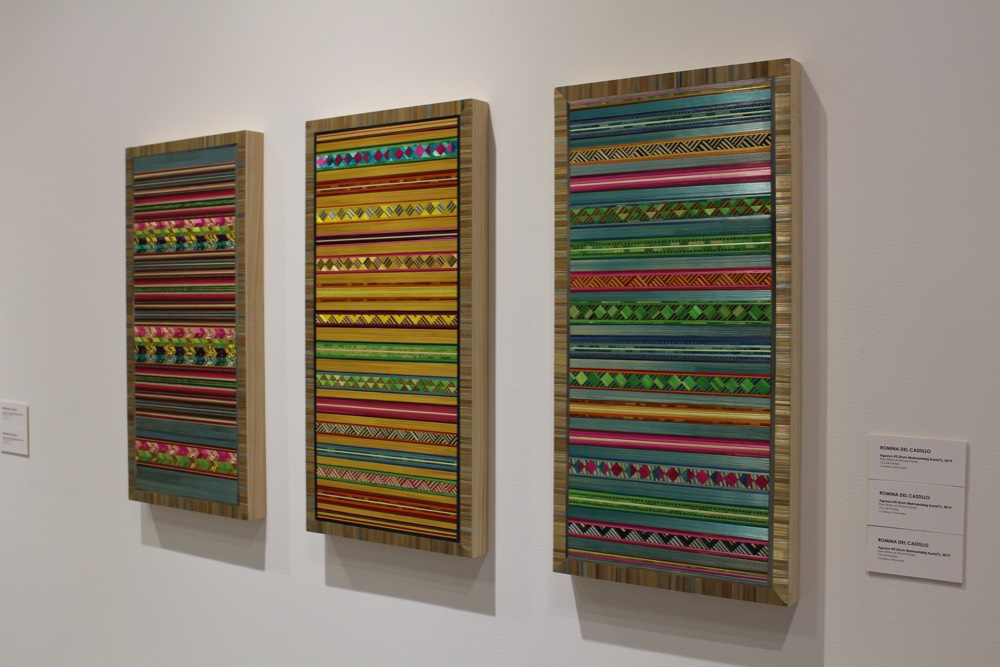
Romina Del Castillo, Aguayo 3 - 5 (From Maimantataj Kanki?), Rye Straw on Wood Panels,
24" by 12" 2018 - 2019.
Romina Del Castillo
Born in Lima and raised by her grandmother, a beloved mentor that she continues to visit annually, Romina Del Castillo’s artistic practice remains close to her Peruvian roots. She has produced a Self-Portrait as Santa Rosa de Lima (the patron saint of Peru) and a series depicting Peruvian camelids (llama, alpaca, guanaco, and vicuña) which interrogates the various semiotic associations that are tied to those animals (for example, Incan royalty wore vicuña fur garments and vicuñas appear on the Peruvian coat of arms, but today the term is a pejorative; synonymous with ‘cholo’ or Indian, highlighting a virulent anti-Indigenous undercurrent in contemporary Peruvian culture). In her most recent travels back to Peru, Del Castillo has become increasingly concerned by the growing social injustice experienced by the indigenous peoples of the region. Her latest series, Maimantataj Kanki? (Quechua for “Where are you from?”) is inspired by traditional Andean aguayos, rectangular woven textiles used by the indigenous people to keep warm and to carry all manner of burdensome loads from groceries to children. Though the designs are inspired by traditional Andean textiles (never from living designers, Del Castillo asserts, to avoid unintentional cultural appropriation), the distinct straw marquetry technique she employs stems from her time as an assistant to the French artist, Paulin Paris (the great- grandson of Carolus Duran, himself a noted mid-19th century painter). Paris’, and now Del Castillo’s, straw marquetry technique, originally developed in 18th century Europe, is the art and craft of applying pieces of veneer to a structure to form decorative patterns, designs or pictures. Del Castillo has recently begun to utilize this marquetry technique to create “ribbons” from straw. The final textile-like image invites the viewer to imagine caressing the colorful surface, a celebration of indigenous design and European ingenuity.
Romina Del Castillo was born in Lima, Peru, raised in Santiago de Chile, and immigrated to the United States at the age of 16. She obtained her Bachelors of Fine Arts with an emphasis on Drawing and Painting at California State University Long Beach. She works in a variety of mediums that include oil, acrylic, graphite, chalk, and charcoal, with observational drawing at the core of her practice. Del Castillo was a recipient of the Orval Dillingham College of the Arts Scholarship and her work has been included in group exhibitions at the Museum of Latin American Art, Torrance Art Museum, Los Angeles Municipal Art Gallery, the University Art Museum at California State University Long Beach, the Brand Library in Glendale. She painted a large mural on the outside of the Cerritos College Fine Arts Building for the FAR Bazaar in 2017. Del Castillo remains an active member of Long Beach’s FA4 Collective, though she has recently relocated to Portland, Oregon.
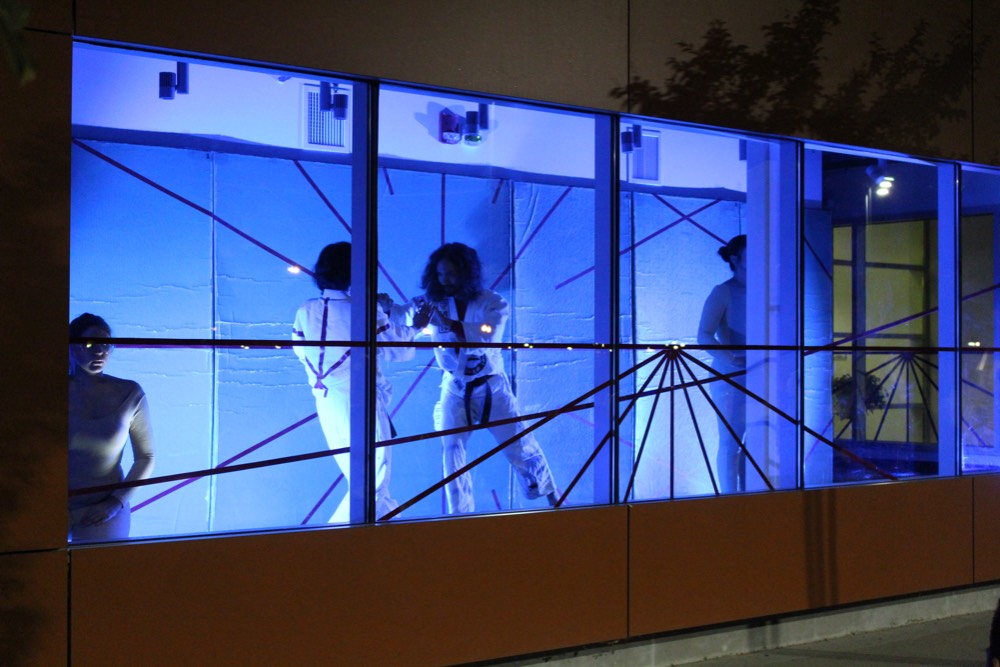
Mariangeles Soto-Diaz, Infinite Unblancing Direstions (Performance), Dojo Mats & Painted
Vinyl, 2019.
Mariangeles Soto-Diaz
Mariángeles Soto-Díaz began her art studies in Venezuela, the promising oil- producing nation that has become one of the most violent and polarized countries in the world. From the fragments of a collapsed modernist project, Soto-Díaz’s work registers the prismatic multiplicity of her own subject position, probing identity through notions of affect, and drawing on Latin American feminism as well as conceptual, political, experimental and abstract languages. Moving freely between performative installations, paintings, instruction-based work, and social and collaborative events, Soto-Díaz explores how mobility and rifts caused by power differentials can be understood and re- imagined. Her newest project, Infinite Unbalancing Directions, made specifically for the 5th SUR:biennial at Cerritos College Art Gallery, is part of an ongoing feminist judo intervention through which she explores judo principles as a way to think through the current onslaught of disturbing socio-political challenges. The work specifically reimagines the judo concept of kuzushi, or unbalancing, as a means to resist and redirect oppositional force. Techniques in judo are often seen as falling within eight possible unbalancing vectors, yet it is also understood that one must quickly adapt to an opponent’s movements in real time, making the actual application of possibilities infinite in variation. Within the exterior display gallery, Soto-Díaz has installed eight used judo mats from the Bunasawakai Dojo, painted with the instructional diagrammatic illustration of the kuzushi vectors. On the window itself, part of the diagram is duplicated and elaborated, such that a viewer walking the periphery of the display will experience a destabilizing parallax effect as the dualing diagrams slide across one another until, ultimately, they finally align, forming a refreshing moment of radical self-centering reflection.
Mariángeles Soto-Díaz studied at the Federico Brandt School of Art in Caracas and
she holds a BA from Hampshire College, a MA from the School of Critical Studies at
the California Institute of the Arts, and an MFA from Claremont Graduate University.
Her work has been exhibited at the Orange County Museum of Art, MASS MoCA, El Museo
del Barrio, the University of Iowa Museum, the Robert and Frances Fullerton Museum
of Art, and the Wignall Museum
of Contemporary Art, among others. She is currently a lecturer at UC Irvine.
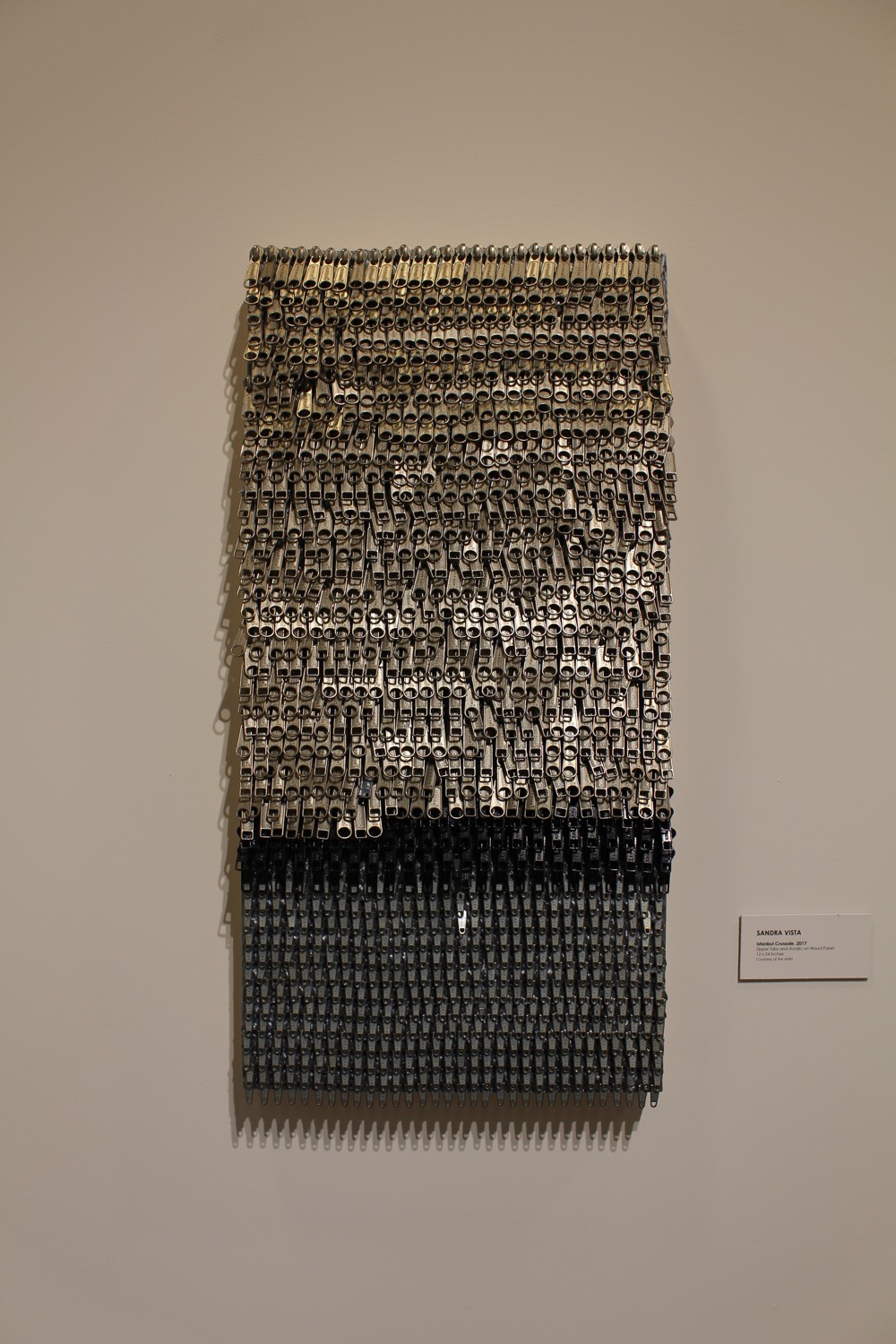
Sandra Vista, Istanbul Crusade, Zipper Tabs & Acylic on Wood, 12" x 24", 2017.
Sandra Vista
Sandra Vista’s artistic practice has always been what one might call design-oriented. Even her earlier work, which focused predominantly on the medium of painting, was largely influenced by the Pattern and Decoration Movement of the 1970s and the Memphis Art Movement of the 1980s. But it was her relocation to downtown Los Angeles twenty years ago, where the Latino and multi- cultural immigrant character of the region is so prevalent, that brought those artistic inspirations into direct exchange with her own Mexican roots, manifesting as a renewed practice of mixed-media sculpture, often with bold florescent colors and shiny iridescent surfaces. A Dada exuberance for the everyday object, a rasquachismo willingness to make do with whatever materials are available, and a feminist impulse to elevate overlooked craft all come together in Vista’s labor-intensive pieces.
Initially, she applied beads and pins to canvases, and later to dried gourds, as she does for three of the pieces in the SUR:biennial. After an impromptu trip to a salvage surplus store, she began working with discarded zipper tabs, applying them in rows to wooden panels. Though the beadwork and gourds could be seen as alluding to indigenous cultural production with similar materials, the zipper works are decidedly more personal and intimate, relating to Vista’s earliest memories and historical accounts of her family. Her father was a purveyor of fabrics and her maternal grandfather was a tailor. In fact, Vista’s largest work in the show, Aurelio of Camp Little, a nine-foot long piece made up of six interconnected panels covered in multi- colored metal zipper tabs, is a direct homage to her grandfather, whose name was Aurelio. After migrating from Chihuahua to El Paso (along with Vista’s grandmother) in 1916 and, ultimately, to Nogales, Arizona, where Vista herself was raised as a child, Aurelio became a tailor, including a stint sewing uniforms for the soldiers stationed at the nearby base known as Camp Little. In her most recent piece, created specifically for the exhibition, Museum Horizon / Horizonte de Museo, Vista amplifies the undercurrent of neo-spirituality that has been ever-present in her work, creating a totemic rupture within the gallery, a ‘zip,’ a la Barnett Newman, made literally out of zippers.
Sandra Vista holds a BA in Art and a California Single Subject Teaching Credential from San Diego State University and a MFA in Painting from Cal State Long Beach. Solo exhibitions include Veinte at Ave 50, Meow Buddha at Vincent Price Art Museum, and Minty Sculptures at Coagula Projects. Her work has been included in group exhibitions at JOAN, Self Help Graphics, San Diego Art Institute, Beyond Baroque, Art Share LA, MuseuMM, Wilding Cran Gallery, Mt. Saint Mary’s College, and Angels Gate Cultural Center.

Stay Connected